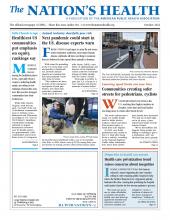
The City of Rockville, Maryland, has installed bike lanes downtown as part of its Vision Zero program. The city is working to eliminate pedestrian fatalities and severe injuries.
Photo courtesy City of Rockville, Maryland
With pedestrian deaths in the U.S. reaching their highest numbers in decades, some state and local leaders are doing more to create safer streets for all.
The work underscores a major U.S. public health need to better protect walkers, rollers and riders from serious injury or death from auto impacts.
In 2022, over 8,600 pedestrians and cyclists in the U.S. died after being hit by a vehicle, according to the National Highway Traffic Safety Administration. Since 2010, pedestrian deaths have increased 75% and are at their highest in 40 years, a June report from Smart Growth America found.
“We’re all healthier and happier when people are biking or walking to get to a destination, and I am shocked that more (people in communities) aren’t making an effort to improve quality of life for all of us,” said Michael Carmody, co-founder of Safer Streets for Kirkwood and St. Louis County, a grassroots advocacy group for pedestrian and cyclist safety in Missouri.
The increase in deaths is due to factors such as speeding drivers, more walkers and bikers along streets, a decline in law enforcement making traffic stops, and drivers distracted by cellphone use and in-vehicle GPS maps, Cathy Chase, executive director of Advocates for Highway and Auto Safety, told The Nation’s Health.
In recent years, some states have given local governments authority to lower city and town speed limits, an ability that is not standard nationwide.
In April, New York legislators passed “Sammy’s law,” named after Sammy Cohen Eckstein, a 12-year-old boy killed after being hit by a car in 2013. The law allows New York City to reduce speed limits to 20 mph on many neighborhood roads. From September through next year, the New York City Department of Transportation plans to reduce speed limits in 250 borough areas.
Research shows lower speeds save lives. A pedestrian hit by a car traveling 20 mph has a 6% chance of life-ending injury, according to a report released in December from Health Resources in Action. If hit by a car traveling 45 miles per hour, a pedestrian is 65% more likely to die from the impact, an 11-fold increase in risk.
In 2016, Seattle lowered speed limits from 25 to 20 mph on residential roads and 30 to 25 mph on arterial roads. Auto crashes dropped by 18.5%, a study by the Insurance Institute for Highway Safety found. In 2017, Boston lowered speed limits from 30 to 25 mph on most city streets. The odds of a driver exceeding 35 mph declined by nearly 30%, a study by the institute found. And the odds of drivers exceeding 30 mph fell 8.5%.

Officials unveil a 25 mph speed limit in St. Paul, Minnesota, in 2020. More cities are lowering speeds to protect pedestrians.
Photo by Leila Navidi, courtesy The Star Tribune/Getty Images
Both projects were part of the Vision Zero program, which over 50 communities in the U.S. have adopted. The program helps local officials develop a comprehensive strategy for safer streets. Reducing speeds is a major part, but so is installing pedestrian islands, designated bike lanes, wider crosswalks and other safety infrastructure.
Vision Zero charts a new path for community planning. For decades, streets got wider, as planners reasoned they improved auto safety. The reality was something different. Drivers felt safer, drove faster and crashed more, helping bump U.S. auto deaths each year to about 40,000.
Vision Zero recommends narrow streets to accommodate pedestrians and bicyclists, creating more cautious drivers who slow their speed because the road is narrower and people are visible, said Bryan Barnett-Woods, principal transportation planner for the City of Rockville, Maryland, which adopted Vision Zero in 2017.
“When we install a curb extension, a pedestrian refuge island, a speed bump, motorists experience those traffic-calming features in the roadway and change their behavior accordingly,” Barnett-Woods told The Nation’s Health. “Narrowing the roadway makes drivers feel that, ‘Oh, I have to be more careful.’”
Through Vision Zero, Rockville has created a master plan for cyclist and pedestrian safety and developed a strategy for rolling out projects.
In December 2021, Rockville, population 66,900, completed pedestrian safety additions and a bike lane to busy Maryland Avenue, including an automated photo enforcement machine that records speeders. Up to 800 citations were written each month before installation of the enhancements, Barnett-Woods said. After installation, citations dropped to between 150 and 300 a month, suggesting drivers were slowing down.
In June, Rockville lowered most city speeds from 40 to 35 mph.
“Speed, crosswalks, pedestrian and bicycle space — all of those elements interact with one another as part of the overall transportation network,” Barnett-Woods said.
Kirkwood, Missouri, is also part of Vision Zero, but the 29,000-population city has struggled to implement pedestrian- and biker-friendly infrastructure, Carmody of Safer Streets for Kirkwood and St. Louis County said.
Since 2020, Safer Streets has lobbied for better road design on bustling Big Bend Road, which runs through the midsection of Kirkwood and accommodates over 20,000 vehicles a day.
In June, a fatal crash at a Big Bend intersection spurred the City Council to adopt a resolution to ask St. Louis County to lower the road’s speed to 30 mph, a 10 mph reduction on some stretches. At a City Council meeting, Carmody applauded the move but reiterated that Big Bend needs a complete redesign to free up safe space for pedestrians and bicyclists.
Safer Streets has had victories over its eight-year history. The organization, for example, successfully lobbied the Missouri Department of Transportation to install enhanced crosswalks in front of North Kirkwood Middle School and a multi-use path along busy Manchester Road near the school. He recommended other advocates keep up the pressure.

Advocates successfully lobbied to have enhanced crosswalks installed in front of a middle school in Kirkwood, Missouri.
Photo courtesy Safer Streets for Kirkwood and St. Louis County
“Our goal is to prevent injuries and deaths to all users of all ability of all ages,” Carmody told The Nation’s Health. “And it can be accomplished through street design.”
For more information, visit www.saferoads.org.
- Copyright The Nation’s Health, American Public Health Association









